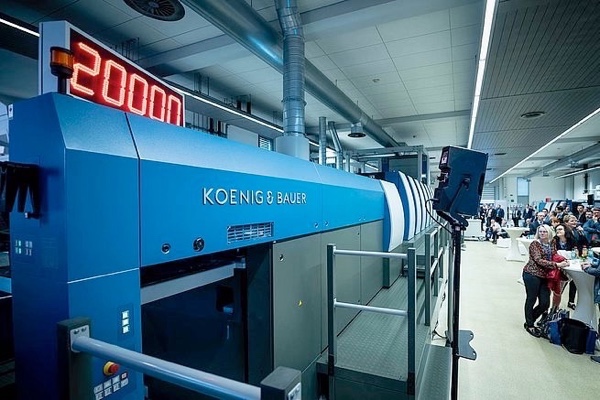Offset Printing
Koenig & Bauer spreads the word on digital transformation and connected services (23)

Monday 27. May 2019 - On 16th and 17th May, Koenig & Bauer invited print professionals from all over the world to an open house spotlighting the potential for digital transformation and data-driven services in commercial printing under the motto Koenig & Bauer 4.0 - Commercial Printing & Connected Services (see also Press Release 0312019).
The event began with a print demonstration on a Rapida 76. It was set up to print a job using the LED?UV technology and served to show that commercial printing comprises more than just 4-over-4 perfecting. Dirk Winker, head of print technology at Koenig & Bauer Sheetfed, took the opportunity to present benefits of the LED-UV technology for commercial printers: Constant high print quality, even greater substrate flexibility, fast further processing and – last but not least – an active contribution to environmental protection.
To keep track of a typically wide-ranging portfolio of commercial jobs, and to ensure that the right products are printed and ready for delivery at the right time, an end-to-end workflow with MIS integration is imperative. Alexander Stern, workflow expert at Koenig & Bauer, explained two concepts from the production perspective:
Standardisation and specialisation on defined products
Unrestricted product variability and creation of a flexible management system to maintain production efficiency irrespective of the complexity
Both approaches are practice-proven and represent functioning business models for the future. The Koenig & Bauer workflow visualises the individual processes along the entire value chain. Optimus Dash controls company processes in real time and offers the necessary flexibility – from order tracking and production, via inventory control and sales administration, through to the management of external services, an interface to accounting and much more besides. Benefits to be derived from this comprehensive functionality include perfect communication between all company departments, lean management practices, the identification of optimisation potential and a clear cost focus.
Fully automatic workflow
A series of typical commercial jobs was defined and sent to a six-colour Rapida 105 PRO with inline coating for production. Key features of this press include a shaftless DriveTronic feeder, DriveTronic SRW, CleanTronic washing systems and the facility to disengage unused inking units. For the demonstration, the press printed fully autonomously in an AutoRun process, during which the operator simply monitors the preselected printing and makeready processes without the need for manual intervention. In this scenario, the Rapida 105 PRO switches automatically between production and makeready at the end of each job. As soon as the measuring systems signal that the quality is good, production of the next job commences without further intervention. AutoRun thus offers the following benefits:
Fully automatic workflow
Optimum utilisation of simultaneous processes
Shortest possible makeready times between jobs
Minimised start-up waste before starting of the sheet counter
The quality assurance systems on the press are important elements of an fully automatic workflow. This means above all the inline measuring system QualiTronic ColorControl, which helps to maintain constant print quality over the whole length of a run. In conjunction with QualiTronic PrintCheck, a parallel sheet inspection can be performed, while QualiTronic PDFCheck additionally compares the printed sheets against the pre-press PDF file. Job-specific reports provide for consistent documentation of the print quality. A traffic-light system informs the printer as to the measured quality.
Printing was followed by cutting. Optimus Dash sends a cutting program to the Perfecta 132 cutting line via the JDF workflow, ensuring that this stage, too, is completed reliably and without errors. On the basis of the arising production times, Optimus generates a cost breakdown with just a few mouse clicks. Terminals linked directly to the post-press machines acquire the relevant production data for the MIS. The open house audience was thus able to witness a fully integrated printshop workflow from data input through to the finished product.
Breakout sessions: High-volume commercial printing and label production
Breakout sessions were devoted specifically to high-volume commercial printing and to label production with corresponding finishing, as well as to more detailed insights into the workings of an MIS. For the high volume session, production was assigned to two Rapida 106 presses in eight-colour configurations for 4 over-4 perfecting one a conventional press and the other with LED-UV capabilities. On the conventional press, QualiTronic PDFCheck demonstrated three different measuring system functions: Inline colour measurement, sheet inspection and comparison of the printed sheet against a pre-press PDF. New here is the fact that all three functions are realised by a single camera system.
When attention turned to the LED-UV press, the visitors could experience at first hand that sheets taken directly from the delivery of the Rapida 106 were already dry and could be passed on for immediate further processing. A diversity of LED-UV jobs was printed without manual intervention by the operator thanks to ErgoTronic AutoRun. As a finale, the highest level of production automation was shown: FlyingJobChange. While one section of the press was in production, makeready for the subsequent job was performed automatically on the remaining units. After automatic engaging and disengaging of the relevant printing units, production of the new job began with practically no interruption: Job changeover time was effectively reduced to zero.
During the other breakout session, the visitors first saw printing and inline finishing on the half-format Rapida 75 PRO. The chosen job demonstrated eye-catching drip-off effects. A six-colour Rapida 106 with cold foil module, coater and RS 106 reel-to-sheet feeder subsequently produced labels at speeds up to 20,000 sheets/hr. All the jobs were followed up with live die-cutting on the Rapida RDC 106. This provided evident proof of the many advantages of a rotary process, including fast makeready even with varying sheet formats, fast job changeovers, exceptional substrate flexibility and high production speeds, all paired with a simple operating concept.
